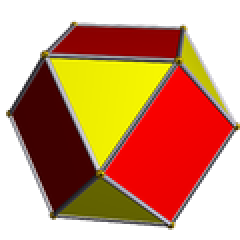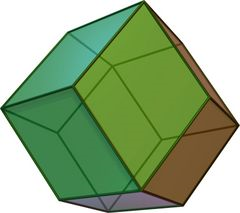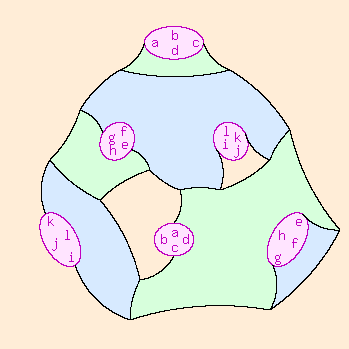dodecahedron
"Regular", as applied to regular maps, has been defined in more than one way. This page considers various definitions that may be used of orientable regular maps. Non-orientable regular maps are not considered here.
We start by describing seven test cases which we will consider as candidates for being "regular". The page leads up to a table with a row for each of the seven, and a column for each of fifteen aspects of regularity. But first we consider edges and flags, and the two symmetry groups associated with any candidate for being a regular map. Then we explain what is shown in each column of the table.
Finally we quote some definitions of "regular" map.

The cube is regular by all standards. All its faces are regular and interchangeable, and all its vertices are regular and interchangeable.
Its Petrie polygons all have six edges.
It has mirror symmetry. Its rotational symmetry group is S4, with 24 elements (twice its number of edges), and its full symmetry group (including reflections) is S4×C2, with 48 elements.
The image above, and the two below, are copied from Wikipedia.

The cuboctahedron is not regular (it is "quasiregular"). Its faces are all regular, but it has two different kinds of face. Its vertices are all interchangeable, but are not regular.
Its Petrie polygons all have eight edges. Its holes all have six edges.
It has mirror symmetry. Its rotational symmetry group is S4, with 24 elements (equal to its number of edges), and its full symmetry group (including reflections) is S4×C2, with 48 elements.

The rhombic dodecahedron is the dual of the cuboctahedron. It is not regular. Its faces are interchangeable, but are not regular, they are rhombi rather than squares. Its vertices are regular, but are not interchangeable: some have three edges, some have four.
Its Petrie polygons all have eight edges.
Like its dual, it has mirror symmetry. Its rotational symmetry group is S4, with 24 elements (equal to its number of edges), and its full symmetry group (including reflections) is S4×C2, with 48 elements.

This may or may not be regarded as regular. Its faces are interchangeable and regular. Its vertices are interchangeable and regular. However, if we walk "east" along an edge until we return to where we have started we traverse two edges, whereas if we walk "north" we traverse one. So the north-south edges are not interchangeable with the east-west edges, and so rotating it through a right angle about the centre of a face is not a symmetry operation.
Its Petrie polygons all have four edges. One of its holes has two edges, two others have one edge each.
It has mirror symmetry. Its rotational symmetry group is C2×C2, with 4 elements (equal to its number of edges), and its full symmetry group is C2×C2×C2, with 8 elements.
(This is not the only way to tile a torus with two squares.

This may or may not be regarded as regular. Its faces are interchangeable and regular. Its vertices are interchangeable and regular. However, each face has two vertices where it has corner-wise contact with itself, and two where it does not; so rotating it through a right angle about the centre of a face is not a symmetry operation.
One of its Petrie polygons has six edges, three others each have two edges. Its holes all have three edges.
It has mirror symmetry. Its rotational symmetry group is D6, with 6 elements (equal to its number of edges), and its full symmetry group is D12, with twelve elements.

This may or may not be regarded as regular. Its faces are interchangeable and regular. Its vertices are interchangeable and regular.
Its Petrie polygons all have ten edges. Its holes all have five edges.
It does not have mirror symmetry. Its rotational symmetry group is C5⋊C4, with 20 elements (twice its number of edges), and its full symmetry group is the same, as it has no reflections.


(Click on the nearer diagram for a larger version.) This is an embedding of the Heawood graph (far right) in S3.
It may or may not be regarded as regular. Its faces are interchangeable and regular. Its vertices are interchangeable by elements of its full symmetry group but not by members of its rotational symmetry group, and are regular.
Its Petrie polygons all have six edges.
However, with a fully regular map, if you rotate one of the faces, each other face "goes somewhere" – that is, some face of the new conformation has the same set of vertices as that face of the original conformation, in the same cyclic order. That is not true of this specimen, unless we forbid rotations of faces by 1/14 of a turn, and only allow rotations by 1/7 of a turn.
It is the Petrie dual of
Its rotational symmetry group is C7⋊C3, with 42 elements (equal to twice its number of edges), and its full symmetry group has 42 elements.
My personal preference is that, of the things listed above, specimens 0 and 5 should be considered regular, and specimens 1, 2, 3 and 4 are not regular. I am undecided about specimen 6.
The cuboctahedron's faces are not all the same; the rhombic dodecahedron's vertices are not all the same; the two-square figure has faces which are, in a sense, rectangular rather than square; similarly the three-square figure's faces are rhombic. However the cube and the five-square figure appear to me to be what I mean by "regular". The latter is chiral, but I don't regard that as making it irregular.
I observe that these two have rotational symmetry groups with twice as many elements as they have edges, and the other candidates do not. But let's consider things in more detail.
In the study of polytopes, a "flag" consists of a vertex, and an edge incident to that vertex, and a face incident to that edge, and a polyhedron incident to that edge, and a polytope incident to that polyhedron, and so on until we have reached the entire polytope. But here, we are only concerned with things that are embedded in a 2-space, so a flag is merely a vertex and an incident edge and an incident face. This is sometimes called a blade. Thus there are four flags for each edge.
Those polyhedra, and regular maps, which are universally regarded as regular are all "flag-transitive". That means that, for any pair of flags, there is some symmetry operation which maps one to the other.
The diagrams below each show an edge, with all four of its flags, and some flags of adjacent edges. In each diagram, two flags are shown in the same colour iff there is a symmetry operation of the full symmetry group of the whole map which maps one to the other.
 Type 0.
Type 0. Type 0b.
Type 0b. Type 1a.
Type 1a. Type 1b.
Type 1b. Type 2.
Type 2. Type 2b.
Type 2b. Type 3.
Type 3.Note that if we consider only the edge itself with its own four flags, type 0 is the same as 0b, and 1a is the same as 1b.
The phrase "half-edge transitive" is ambiguous. Edges of types 0, 1a, and 1b are definitely half-edge transitive. It is not clear users of whether users of this phrase intend to cover edges of types 2 and 3.
In this section we explain the column heading in the table below.
| F-t | Face-transitive. The faces are interchangeable. For any two faces, there is a symmetry operation which maps one to the other. |
|---|---|
| F:E-t | Faces edge-transitive. For a face, its edges are interchangeable. For any two edges of that face, there is a symmetry operation which maps one to the other, while fixing the face as a whole. |
| F-r | Faces rotate. For a face, there is a symmetry operation which maps each edge to the next one around. |
| V-t | Vertex-transitive. The vertices are interchangeable. For any two vertices, there is a symmetry operation which maps one to the other. |
| V:E-t | Vertices edge-transitive. For a vertex, its edges are interchangeable. For any two edges of that vertex, there is a symmetry operation which maps one to the other, while fixing the vertex as a whole. |
| V-r | Vertices rotate. For a vertex, there is a symmetry operation which maps each edge to the next one around. |
| E-t | Edge-transitive. The edges are interchangeable. For any two edges, there is a symmetry operation which maps one to the other. |
| d-t | Dart-transitive. The darts are interchangeable. For any two darts, there is a symmetry operation which maps one to the other. |
| b-t | Flag-transitive. The flags are interchangeable. For any two flags, there is a symmetry operation which maps one to the other. (b stands for blade. I don't use f-t for flag-transitive, to avoid confusion with F-t.) |
| rsg/E | The ratio of the size of the rotational symmetry group to the number of edges |
| fsg/E | The ratio of the size of the full symmetry group to the number of edges |
| E? | The "edge type", as listed in the section on flags, above. |
| mirror | The map has (with the full symmetry group) mirror symmetry. |
| PPs | The Petrie polygons are all the same size. An integer means they are, and is that size. |
| holes | The holes are all the same size. An integer means they are, and is that size. A space means that the concept of hole is meaningless for the map. |
Any regular map, and indeed any embedding of a map in a surface, is associated with two symmetry groups. Its rotational symmetry group "RSG" comprises those symmetry operations that correspond to rotations of the map, sliding it within the surface. Its full symmetry group "FSG" also contains elements that correspond to relections. If the surface is non-orientable, the two groups must be the same. If the surface is orientable, then either the FSG is twice the size of the RSG, having the RSG as a normal subgroup; or the two groups are the same and the map is chiral.
For the nine columns of the table, from F-t to b-t, R means that an element of the rotational symmetry group does the mapping in question; F means that an element of the full symmetry group but not of the rotational symmetry group does the mapping in question; and N means that there is no symmetry operation that does it.
| Map | F-t | F:E-t | F-r | V-t | V:E-t | V-r | e-t | d-t | b-t | rsg/E | fsg/E | E? | mirror | PPs | holes | ||||||
|---|---|---|---|---|---|---|---|---|---|---|---|---|---|---|---|---|---|---|---|---|---|
| Cube | R | R | R | R | R | R | R | R | F | 2 | 4 | 0 | Y | 6 | |||||||
| Cuboctahedron | N | R | R | R | F | N | R | F | N | 1 | 2 | 2 | Y | 8 | 6 | ||||||
| Rhombic dodecahedron |
R | F | N | N | R | R | R | N | N | 1 | 2 | 3 | Y | 8 | |||||||
| Two squares | R | N | N | R | N | N | N | N | N | 1 | 2 | 0b | Y | 4 | N | ||||||
| Three squares | R | F | N | R | F | N | F | N | N | 1 | 2 | 1a | Y | N | 3 | ||||||
| Five squares | R | R | R | R | R | R | R | R | N | 2 | 2 | 1b | N | 10 | 5 | ||||||
| S3:{14,3} | R | F | N | F | R | R | R | F | N | 1 | 2 | 2b | Y | 10 | 5 | ||||||
| No. | Source | reference | quotation | Effect |
|---|---|---|---|---|
| 1 | Conder, "Regular maps on non-orientable surfaces" (1996) | C96 | ... the order of Aut M is bounded above by the number of flags, and when this upper bound is attained, Aut M acts transitively, indeed regularly, on flags, and M is called a (reflexible) regular map. | fsg/E is 4 |
| 2 | Conder and Dobcsányi, "Determination of all Regular Maps of Small Genus" (2001) | C01 | ... if there exist automorphisms R and S with the property that R cyclically permutes the consecutive edges of some face f (in single steps around f), and S cyclically permutes the consecutive edges incident to some vertex v of f (in single steps around v), then following Wilson we may call M a rotary map. Under the more currently acceptable terminology, M is also called a regular map (in the sense of Brahana). | F-r is F or R; so is V-r |
| 3 | van Wijk, "Symmetric Tiling of Closed Surfaces: Visualization of Regular Maps" (2009) | W09 | A map is regular if its associated automorphism group contains R [an element rotating a face by one place] and S [an element rotating a vertex by one place] as automorphisms ... | |
| 4 | McMullen and Schulte, "Abstract Regular Polytopes" (2002), p. 9 | ARM | Page 17: P is called regular if G(P) is transitive on the family ... of flags of P [page 8 also specifies that a face may not share a vertex with itself] |
b-t is F or R |
| 5 | Conder, "Regular maps and hypermaps of Euler characteristic -1 to -200" (2009) | C09 | A map M is called regular if the group Aut(M) of all its automorphisms has a single orbit on incident vertex-edge-face triples. | |
| 6 | An orientably-regular map is a map M on an orientable surface with the property that the group Auto(M) of all its orientation-preserving automorphisms has a single orbit on incident vertex-edge pairs ... | d-t is R |
Definitions 1, 4 and 5 accept the cube as regular and reject the other six specimens. Definitions 2, 3 and 6 also accept the chiral "five squares", and reject the other five specimens.
For a demonstration of how far one can go wrong in defining "regular", see this
paperweight puzzle and its solution.
Index to other pages on regular maps.
Copyright N.S.Wedd 2009,2010